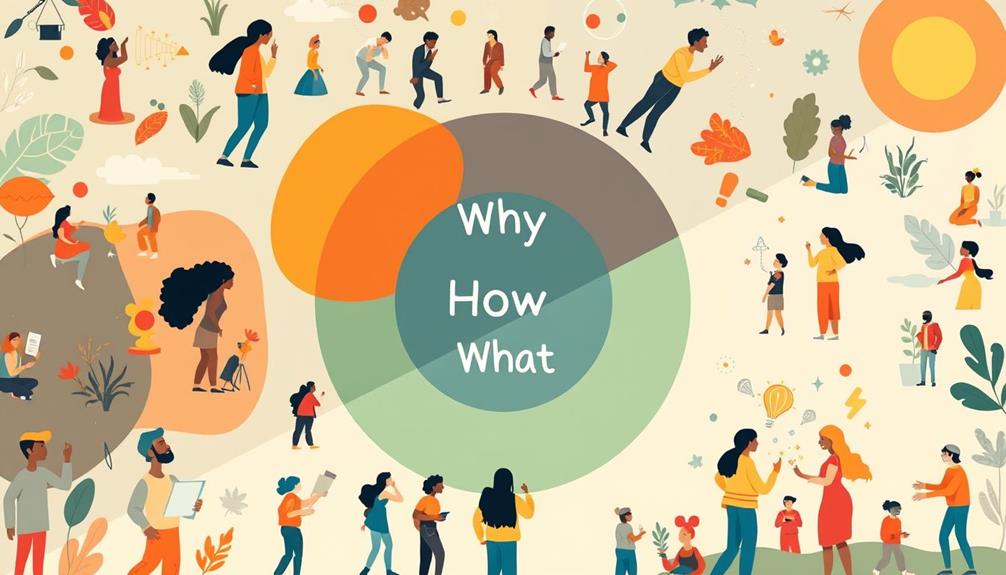To discover your 'Why,' Simon Sinek's Golden Circle is a powerful tool. It emphasizes the importance of knowing your core purpose and belief. Great leaders inspire action by effectively communicating this purpose, creating trust and alignment within teams. Engaging your team in challenges fosters unity and shared goals, enhancing motivation. Sinek's quotes remind you that a clear 'Why' propels you forward and inspires innovation. Understanding your emotional connections boosts loyalty and drives success. If you want to explore more about how these insights can transform your journey, there's plenty more to uncover.
Key Takeaways
- "People don't buy what you do; they buy why you do it." This highlights the importance of articulating your core purpose.
- "Your 'Why' is the reason you get out of bed in the morning." Understanding your motivation drives passion and commitment.
- "Start with why." This emphasizes the need to communicate purpose before methods or results.
- "When you are clear on your 'Why,' the 'How' and 'What' become easier to define." A clear purpose simplifies decision-making and actions.
- "The goal is not to be perfect by the end, but to be better today." This encourages continuous improvement aligned with your 'Why'.
Understanding Your 'Why'
Understanding your 'Why' is essential for both personal growth and organizational success. Your 'Why' represents your core purpose, belief, and motivation, guiding every decision you make. When you start with 'Why', you engage your limbic brain, the emotional center that drives behavior and inspires action. This connection fosters loyalty among your team and audience.
By aligning your goals with your 'Why', you can effectively track progress and maintain motivation, ensuring that your objectives resonate with your deeper values and aspirations, as emphasized in goal tracking tips.
Effective communication must follow the sequence of 'Why' → 'How' → 'What'. By articulating your purpose before diving into processes or products, you create a foundation for genuine engagement. Unfortunately, many organizations focus too heavily on 'What' and 'How', neglecting their 'Why'. This oversight leads to disconnection from their audience and diminished emotional engagement.
When you clearly understand and communicate your 'Why', you foster alignment within your team. This clarity encourages collaboration, ownership, and trust, ultimately driving organizational success. Each member becomes more engaged, sharing a common purpose that fuels their passion and commitment.
Inspiring Leadership Quotes

Inspiring leadership starts with a clear articulation of your 'Why'. When you communicate your purpose effectively, you inspire those around you.
Great leaders understand that "Great leaders inspire action by clearly communicating the purpose behind their actions." This focus on 'Why' builds trust, encouraging loyalty and engagement within your team.
Sinek emphasizes that "Trust is foundational for company success; leaders must be vulnerable." By being open about your vision, you foster an environment ripe for collective action. Engaging in group challenges can further enhance this sense of community and shared purpose among team members.
Leadership isn't just about directing; it's about motivating others to lead. As Sinek puts it, "Leadership success relies on inspiring others to become leaders themselves." This transformational approach stems from a compelling 'Why', which can truly resonate with your team and propel them forward.
Moreover, effective change requires you to communicate from 'Why' to 'What'. Sinek notes, "A clear vision fosters a movement towards a better future," reinforcing the importance of that initial purpose.
Empowering Teams Through Attitude

Empower your team by prioritizing attitude over skills during the hiring process. A positive attitude fosters collaboration and morale, which are crucial for creating a thriving work environment. Skills can be taught, but an inherent positive attitude is essential for team cohesion and growth.
| Key Element | Importance | Action Steps |
|---|---|---|
| Positive Attitude | Enhances team dynamics | Hire based on attitude |
| Responsibility | Increases accountability | Delegate tasks effectively |
| Alignment with Values | Guarantees cultural fit | Evaluate candidates' beliefs |
| Encouraging Innovation | Drives creativity | Foster an open environment |
| Regular Check-ins | Builds confidence | Provide supportive coaching |
When you empower team members by giving them responsibility, you enhance their sense of accountability and motivation. This creates a culture where everyone feels valued and engaged. As a leader, evaluating candidates for alignment with your company values guarantees a strong cultural fit, promoting collaboration and innovation. Additionally, by being vulnerable and trustworthy, you lay the foundation for strong relationships. Regular check-ins and coaching help develop skills and confidence, contributing to a workplace focused on growth and collaboration.
The Role of Listening

Listening plays an essential role in fostering effective communication and building trust within a team. It goes beyond merely hearing words; it involves grasping the emotions and meanings behind them. When you create an open space for dialogue, team members feel safe to express their thoughts and concerns. This encourages greater engagement and collaboration, enhancing overall team dynamics.
Additionally, mental health screenings in older adults highlight the importance of understanding emotional states, which can directly influence team interactions.
By inviting employees to "empty the bucket," you allow them to share their feelings and ideas, which can lead to valuable insights. Replacing judgment with curiosity during conversations transforms interactions into meaningful dialogues, further strengthening trust among team members. Regular check-ins and active listening not only improve communication but also contribute to a positive work environment.
When employees feel heard, their well-being improves, leading to increased loyalty to the organization. By prioritizing listening, you cultivate a culture where everyone feels valued and empowered, ultimately driving team success.
Practical Applications of 'Why

Understanding your 'Why' can transform the way you approach your work and interactions within your organization. When you define your 'Why', you create a clear vision that not only guides your decisions but also enhances employee engagement. This alignment creates a more cohesive work environment, where individuals feel empowered to contribute meaningfully to enhancing content credibility.
People are more likely to commit to goals that resonate with their personal values, fostering a deeper connection to their work. By articulating your 'Why', you can inspire action and cultivate an organizational culture that prioritizes innovation and collaboration.
This alignment between individual motivations and the collective purpose leads to greater accountability, as team members feel a sense of ownership over their contributions. Moreover, focusing on your 'Why' helps in building emotional connections with customers.
When they understand your purpose, they're more likely to trust and remain loyal to your brand, differentiating you in competitive markets. Encouraging employees to explore their personal 'Why' not only enhances their fulfillment but also amplifies the overall impact of your organization.
When everyone is aligned with a common purpose, you empower them to innovate and excel, ultimately driving success for the entire team.
Frequently Asked Questions
What Was Simon Sinek's Famous Quote?
One of Simon Sinek's famous quotes is, "People don't buy what you do; they buy why you do it." This emphasizes the importance of understanding and communicating your core purpose to inspire action and connection.
What Is a Famous Quote About Knowing Your Why?
Discovering your direction drives determination. A famous quote states, "People don't buy what you do; they buy why you do it," reminding you that understanding your purpose inspires passion and fosters deeper connections with others.
What Is the Quote About Remembering Your Why?
Remembering your 'Why' keeps you grounded and focused. It shapes your decisions and inspires your actions. When challenges arise, that core purpose guides you, ensuring you remain true to your values and aspirations.
What Is the Why in the Golden Circle?
Imagine waking up, feeling lost. What drives you? Your "Why" is your core purpose, the reason behind your actions. It inspires you and others, creating meaningful connections and guiding decisions in every aspect of your life.
Conclusion
Just as a compass guides a traveler through uncharted territory, your 'why' directs your journey in life. By embracing Simon Sinek's Golden Circle, you reveal the treasure of purpose, inspiring not just yourself but also those around you. When you listen and nurture your team's strengths, you're planting seeds that blossom into collaboration and innovation. So, chart your course with clarity, and watch as your passion lights the way for others to follow.
Joy, as our Editor in Chief, ensures the highest standard of content. Her talent in writing is complemented by her attention to detail and passion for literature and culture. Joy’s expertise and love for the English language shine through in her editorial work, making each piece a testament to quality and clarity.










